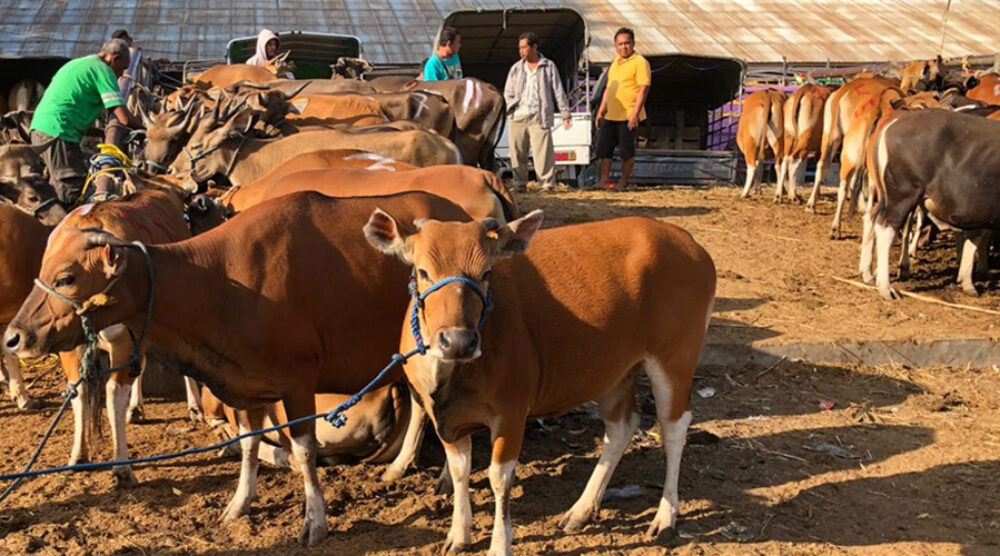DOMINIC SMITH AND TARNI COOPER |
Livestock play a vital role in Indonesia’s economy, underpinning livelihoods and food security, and holding cultural significance across the nation. However, despite their importance, accurate estimations of livestock biomass and value have been lacking. This gap in information hinders effective policymaking, investment decisions, and disease management strategies.
As part of the Global Burden of Animal Diseases program, a recent study has provided the first estimates of livestock biomass and value by province in Indonesia. The findings highlight the economic significance of the livestock sector and underscore the regional disparities and challenges to be addressed.
Breaking the data down by province unveils the regional significance of certain livestock types, such as pigs in East Nusa Tenggara and sheep in West Java.
Combined measures of livestock biomass and human biomass can be also used to estimate potential environmental resource pressures in different geographic regions.
The study aims to achieve several objectives: firstly, to provide the first estimation of the biomass and value of key livestock types by province in Indonesia; secondly, to validate the key population data underlying these estimates using herd dynamic modelling; and finally, to assess the sensitivity of biomass and livestock value estimations to stochastic variations of key input parameters.
Importance of accurate data
Accurate data on livestock biomass and value are essential for several reasons. Firstly, they serve as a basis for estimating the economic contribution of the livestock sector to the overall GDP, which was approximately 4.5 per cent in 2021. This information is vital for policymakers advocating for resource allocation and financing for the livestock sector.
Moreover, accurate population data are a necessary first step to calculating the burden of animal diseases. Detailed breakdowns of livestock value by province and species enable policymakers to perform cost-benefit analyses of livestock development and disease management policies. By understanding the economic impact of animal diseases on different regions and species, targeted interventions can be implemented to mitigate losses and protect livelihoods.
Insights from the study
The findings of the study revealed several key issues:
Total biomass: Livestock biomass in Indonesia was estimated at 12.2 million tonnes in 2021, representing a significant portion of the country’s overall biomass. Beef cattle and broiler chickens were identified as the primary contributors to total biomass.
Regional disparities: Livestock biomass and value varied significantly across provinces. While Java and Bali provinces exhibited the highest overall livestock biomass, outlying provinces, such as East Nusa Tenggara, demonstrated higher per capita values. These regional differences underscore the need for tailored policies to address specific challenges and opportunities.
Future directions
Animal health loss envelope: Building upon the estimates of livestock value, future research will focus on calculating an Animal Health Loss Envelope (AHLE) to quantify the economic losses associated with animal diseases.
Value chain analysis: Expanding the analysis to cover the value added at each stage along the livestock value chain will provide valuable insights into the socio-economic impacts of animal diseases on different stakeholders.
Localised impact assessments: Conducting in-depth assessments of disease impacts at the farmgate level in specific regions and species will inform targeted disease control measures and resource allocation strategies.
Conclusion
Accurate estimations of livestock biomass and value are critical for informed policymaking, investment decisions, and disease management strategies. By providing the first estimates of livestock biomass and value in Indonesia, this study represents a significant step toward addressing this information gap. Moving forward, further research initiatives will be essential to deepen our understanding of livestock socioeconomics and strengthen the resilience of Indonesia’s livestock sector against emerging challenges.
Research seminar recording
Dominic Smith and Tarni Cooper are members of the Griffith Asia Institute.
Please click here to view the published journal article titled “Calculation of livestock biomass and value by province in Indonesia: Key information to support policymaking” by Dominic Smith, Nyak Ilham, Riyandini Putri, Ermin Widjaja, Widagdo Sri Nugroho, Tarni Cooper, Harimurti Nuradji, Ni Luh Putu Indi Dharmayanti and Dianne Mayberry.








